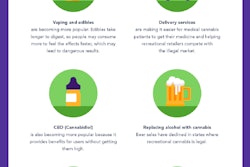
While growth was not as explosive as first predicted, monthly cannabis sales have more than doubled in less than a year, growing from about $41 million in October of 2018 to about $97.3 million in August of 2019. Currently, the Canadian cannabis market is on track to reach nearly $6 billion in revenue by 2024.
PMMI Business Intelligence’s white paper, “Cannabis Market Update: Unique Packaging Challenges for THC and CBD Products,” explains that the Canadian cannabis market growth started out slower than expected, primarily due to restrictions of the rollout.
During the first year of sales cannabis products were restricted to flower and lower concentration oils intended for sublingual consumption, effectively banning other formats of cannabis for one year - including concentrates, edibles, and vape cartridges. In addition, on-site sales at physical locations were banned for the first six months in favor of an online shipping system.
Additionally, the process of approval for growing licenses has been slow and restrictive, creating a backlog of applications that took over a year to process. This slowdown created supply problems in the first year of legalization, although the problem appears to be correcting itself as adjustments to the application process boosted backstock of dried cannabis in the fourth quarter of 2019 to three times what it was the previous year in October of 2018.
Licensing has also been an issue on the dispensary side, where a slow and burdensome process stalled dispensary openings in some provinces. Each province is responsible for dispensary licensing within their territory, resulting in a patchwork of regulations that has created a shortage of physical dispensaries in the most populated provinces. And while the Canadian market allows online ordering to supplement physical dispensary sales, the lack of storefronts has been an obstacle for cannabis companies working to grow their operations.
Illegal sales of cannabis have also proved difficult to eliminate in Canada despite a maximum tax of 10% on cannabis products. In 2019, legal cannabis sales accounted for only 29% of the Canadian market, while the black market still held a 71% share of all cannabis sales. Black market sales are expected to be slashed to about 35% in 2020, but the share of illegal cannabis sales in 2019 significantly hampered the growth of legal cannabis sales.
Health Canada has established a national guide to packaging and labeling requirements for cannabis products, regardless of province, type or format.
Health Canada packaging guidelines for cannabis products include:
· A single uniform color
· Smooth texture
· No hidden features
· No features that can change surface area






















